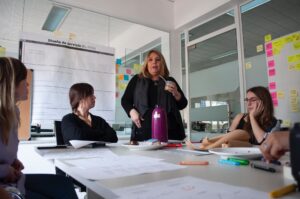One Piece Flow is a manufacturing process that involves producing one product at a time from start to finish, rather than producing products in batches.
This process is also referred to as Single-Piece Flow or Continuous Flow. The goal of One Piece Flow is to eliminate waste, reduce inventory, and improve the quality of the product.
Implementing One Piece Flow in manufacturing processes is important because it can lead to significant improvements in efficiency and productivity.
By producing one product at a time, the process can be streamlined, and resources can be used more efficiently. It also helps to reduce lead times, as products can be completed and delivered more quickly.
The steps involved in implementing One Piece Flow include assessing the current state of the process, designing the future state, implementing One Piece Flow, and continuous improvement.
These steps involve analyzing the current process, identifying areas for improvement, designing a new process flow, implementing the new process, and continuously monitoring and improving the process.
Table of Contents
Step 1: Assess the Current State
The first step in implementing One Piece Flow is to assess the current state of the manufacturing process. This involves conducting a detailed analysis of the existing process to identify bottlenecks and areas for improvement. The following are the key activities involved in assessing the current state:
- Conducting a Value Stream Mapping Exercise: Value Stream Mapping is a visual tool used to map out the steps in the manufacturing process and identify areas of waste. It helps to identify the value-added and non-value-added activities in the process. By creating a visual map of the process flow, it is easier to identify inefficiencies and bottlenecks.
- Analyzing the Current Process Flow: Once the value stream map is created, the current process flow needs to be analyzed in detail. This involves looking at each step in the process and identifying any inefficiencies or bottlenecks. The goal is to identify any activities that do not add value to the product or process and eliminate them.
- Identifying Bottlenecks and Waste in the Process: The next step is to identify any bottlenecks in the process that slow down production or cause delays. This includes identifying waste such as overproduction, waiting, excess inventory, unnecessary transportation, defects, and unused talent. By identifying and eliminating bottlenecks and waste, the manufacturing process can be made more efficient.
- Collecting Data on Cycle Time, Lead Time, and Process Efficiency: To assess the current state of the process, it is important to collect data on cycle time, lead time, and process efficiency. Cycle time is the time it takes to complete one unit of production, while lead time is the time it takes from the start of the process to the delivery of the finished product. Process efficiency measures how well resources are being used in the process. By collecting and analyzing this data, it is possible to identify areas where improvements can be made.
By completing this step, it is possible to identify the strengths and weaknesses of the current manufacturing process and develop a plan for improvement. The next step is to design the future state of the process.
Step 2: Design the Future State
The second step in implementing One Piece Flow is to design the future state of the manufacturing process. This involves creating a new process flow that eliminates waste and improves efficiency. The following are the key activities involved in designing the future state:
- Creating a Future State Map: A future state map is a visual representation of the ideal flow of the manufacturing process. It is created by identifying and eliminating waste in the current process flow. The future state map outlines the ideal flow of the process, including the steps required to produce the product and the time required to complete each step.
- Identifying the Ideal Flow of the Process: The goal of the future state map is to create an ideal flow of the manufacturing process. This involves identifying the most efficient way to produce the product, eliminating any unnecessary steps, and ensuring that the process flows smoothly from start to finish.
- Identifying the Process Steps Required to Achieve the Future State: Once the ideal flow of the process has been identified, the next step is to identify the process steps required to achieve the future state. This involves breaking down the process into individual steps and ensuring that each step is necessary and adds value to the process.
- Designing the Layout of the Workstations and Machines Required for the Process: To achieve the future state, it may be necessary to rearrange the workstations and machines required for the process. The goal is to create a layout that minimizes waste, reduces lead times, and improves efficiency.
By completing this step, it is possible to design a new process flow that is more efficient and eliminates waste. The next step is to implement One Piece Flow in the manufacturing process.
Step 3: Implementing One Piece Flow
The third step in implementing One Piece Flow is to put the new process into action. This involves breaking down the process into small, manageable steps, creating standard work instructions for each step, training employees on the new process, and setting up a visual management system to monitor progress and identify issues. The following are the key activities involved in implementing One Piece Flow:
- Breaking Down the Process into Small, Manageable Steps: To implement One Piece Flow, it is important to break down the process into small, manageable steps that can be completed efficiently. This involves identifying the specific tasks required to produce the product and creating a sequence of steps that can be followed to complete each task.
- Creating Standard Work Instructions for Each Step: Once the process has been broken down into small steps, it is important to create standard work instructions for each step. These instructions should include a description of the task, the time required to complete the task, and any specific tools or equipment required.
- Training Employees on the New Process: To ensure that the new process is implemented successfully, it is important to provide training to employees on the new process. This includes training on the new work instructions, as well as any new equipment or tools that may be required.
- Setting Up a Visual Management System to Monitor Progress and Identify Issues: To ensure that the new process is running smoothly, it is important to set up a visual management system to monitor progress and identify any issues that arise. This can include visual indicators such as charts, graphs, or dashboards that show how the process is performing in real-time.
By completing this step, it is possible to implement One Piece Flow in the manufacturing process and begin producing products more efficiently. The next step is to continuously improve the process.
Step 4: Continuous Improvement
The final step in implementing One Piece Flow is continuous improvement. This involves monitoring the process regularly to identify areas for improvement, implementing changes to improve process efficiency and quality, and conducting regular audits to ensure adherence to the One Piece Flow process. The following are the key activities involved in continuous improvement:
- Monitoring the Process Regularly to Identify Areas for Improvement: To continuously improve the process, it is important to monitor the process regularly to identify areas for improvement. This can include tracking key performance indicators such as cycle time, lead time, and defect rate, and using data analysis tools to identify areas for improvement.
- Implementing Changes to Improve Process Efficiency and Quality: Once areas for improvement have been identified, it is important to implement changes to improve process efficiency and quality. This can include making changes to the process flow, adjusting work instructions, or introducing new equipment or tools.
- Conducting Regular Audits to Ensure Adherence to the One Piece Flow Process: To ensure that the One Piece Flow process is being followed correctly, it is important to conduct regular audits. This can include conducting process audits to ensure that work instructions are being followed correctly, or conducting equipment audits to ensure that machines are being used properly.
By continuously improving the process, it is possible to achieve even greater efficiencies and improve product quality. This cycle of continuous improvement is key to the long-term success of the One Piece Flow process.
Benefits of One Piece Flow
Implementing One Piece Flow in manufacturing processes can bring numerous benefits to a company. Some of the key benefits are:
Improved product quality
One Piece Flow eliminates the need for inventory and batch processing, reducing the potential for defects and errors. This can result in improved product quality and reliability.
Reduced lead times
One Piece Flow streamlines the production process and reduces waiting time, resulting in faster lead times. This can help companies respond more quickly to changing customer demands.
Reduced inventory
One Piece Flow eliminates the need for large inventories of partially completed products. This can reduce the cost of inventory holding and the risk of obsolete inventory.
Improved employee morale and engagement
One Piece Flow promotes teamwork and collaboration among employees, which can lead to improved morale and engagement. By empowering employees to take ownership of their work and make continuous improvements, they become more invested in the success of the company.
Improved customer satisfaction
One Piece Flow can result in faster delivery times and improved product quality, leading to increased customer satisfaction. By delivering high-quality products quickly, companies can gain a competitive edge in the market.
Overall, implementing One Piece Flow can help companies achieve greater efficiency, productivity, and profitability, while also improving the quality of products and the satisfaction of customers and employees.
Conclusion
In conclusion, One Piece Flow is a lean manufacturing approach that can help companies achieve greater efficiency and productivity in their production processes.
By optimizing the flow of work and eliminating waste, companies can improve product quality, reduce lead times, and reduce inventory levels, among other benefits.
Implementing One Piece Flow involves four key steps: assessing the current state, designing the future state, implementing One Piece Flow, and continuous improvement.
Each of these steps is essential to achieving the desired outcomes and ensuring the sustainability of the process.
Continuous improvement is a critical component of the One Piece Flow process. By monitoring the process regularly and making continuous improvements, companies can achieve even greater efficiency, productivity, and quality in their manufacturing processes.
In today’s highly competitive market, implementing One Piece Flow can give companies a significant advantage over their competitors.
By eliminating waste and optimizing the flow of work, companies can reduce costs, improve quality, and deliver products to customers more quickly.
In conclusion, we encourage companies to consider implementing One Piece Flow in their manufacturing processes to achieve the benefits discussed in this article.
By following the steps outlined and making continuous improvements, companies can achieve sustainable success and growth in the long term.




